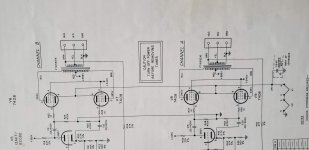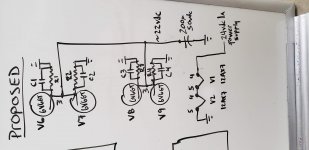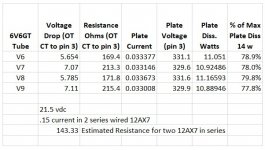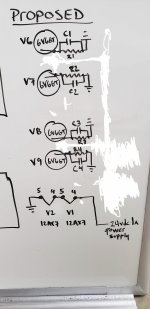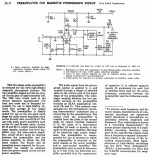Hi all, I need some advice and guidance.
I have a HK A300 stereo tube amp.
Presently the output tubes are biased throught the 12AX7 tubes.
I want to split the 4 output tubes from the 12AX7 preamp tubes to allow me to individually bias each output tube (orignal Schematic of output section attached)
1. Is my proposed wiring diagram correct and functional? Attached
2. I could use some help in determining the R values and wattage rating, and the C values.
My specific BIAS readings are attached.
I see that some tube datasheets provide a rating for the resistor, unfortunately there is none provided on this tube datasheet. Attached
I assume I need to calculate it. I estimate is at 143 ohms. 21.5 vdc / .15 = 143 ohms for each R, correct?
I've researched and researched, but only confused myself by finding lots of contradictory information.
I would really appreciate some help determining the correct values and an explanation of the calcs, or a few links to some explanations you know to be accurate so I can learn.
Other notes:
I will have a separate transformer wired to provide regulated 24Vdc to 12AX7 heaters
I estimate that the 12AX7 tubes are providing 143.33 total resistance
Resistance and voltage drop was measured from OT center tap to pin 3 of each 6v6GT
The amp is powered via a 117Vac bucking transformer at all times
This is a Harman Kardon A300 stereo tube amplifier from the 60's
The output tubes are 6V6GT EH. Spec sheet attached.
Thanks in advance
I have a HK A300 stereo tube amp.
Presently the output tubes are biased throught the 12AX7 tubes.
I want to split the 4 output tubes from the 12AX7 preamp tubes to allow me to individually bias each output tube (orignal Schematic of output section attached)
1. Is my proposed wiring diagram correct and functional? Attached
2. I could use some help in determining the R values and wattage rating, and the C values.
My specific BIAS readings are attached.
I see that some tube datasheets provide a rating for the resistor, unfortunately there is none provided on this tube datasheet. Attached
I assume I need to calculate it. I estimate is at 143 ohms. 21.5 vdc / .15 = 143 ohms for each R, correct?
I've researched and researched, but only confused myself by finding lots of contradictory information.
I would really appreciate some help determining the correct values and an explanation of the calcs, or a few links to some explanations you know to be accurate so I can learn.
Other notes:
I will have a separate transformer wired to provide regulated 24Vdc to 12AX7 heaters
I estimate that the 12AX7 tubes are providing 143.33 total resistance
Resistance and voltage drop was measured from OT center tap to pin 3 of each 6v6GT
The amp is powered via a 117Vac bucking transformer at all times
This is a Harman Kardon A300 stereo tube amplifier from the 60's
The output tubes are 6V6GT EH. Spec sheet attached.
Thanks in advance
Attachments
The filament string resistance is 24VDC/150mA = 160R. Use four times that for each output tube.
This will be 4 x 160R = 640R, each one dissipating 24Vx24V/640R = 0.9W. Use a 620R, 3W resistor.
All the cathodes are separately biased with a 620R resistor each, and not connected together.
Use the parallel C for each 620R set at 10Hz, so C = 1 / (2Pi x 620 x 10 ) = 25uF, use a 27uF/50V capacitor.
For 2Hz use a 100uF cap.
This will be 4 x 160R = 640R, each one dissipating 24Vx24V/640R = 0.9W. Use a 620R, 3W resistor.
All the cathodes are separately biased with a 620R resistor each, and not connected together.
Use the parallel C for each 620R set at 10Hz, so C = 1 / (2Pi x 620 x 10 ) = 25uF, use a 27uF/50V capacitor.
For 2Hz use a 100uF cap.
Last edited:
4X completely independent RC bias networks is what you're looking for. I revised the proposed schematic.
FWIW, I totally agree with eliminating "Cheap Charlie" DC heaters in the phono section. Only 150 mA. are needed from a "24" V. supply or 300 mA. from a "12" V. supply.
FWIW, I totally agree with eliminating "Cheap Charlie" DC heaters in the phono section. Only 150 mA. are needed from a "24" V. supply or 300 mA. from a "12" V. supply.
Attachments
Four separate cathode resistors will limit the output stage to class A (with perhaps 8 watts or less) before distorting. Better to pair them with half the resistor value. Actually a single resistor for all four would give a little more peak power.
ScottyMcCrow,
I owned a HK A300.
The small output transformers (OPT) absolutely require that the currents in each pair of 6V6 be balanced.
If the currents are unbalanced, you get early saturation of the OPT, bad bass, and more than normal intermodulation of the bass notes on the mids and highs. Negative feedback can not cure everything, there are limits. In fact, as the core saturates, the negative feedback will make it even more saturated in an attempt to 'correct' the signal.
Purchase very well matched tubes, and hope for the best (may be matched at a different operating point.
Or, use individual self bias resistors and bypass caps, just as you have proposed.
you can easily measure the cathode voltage of each tube, and see how well the currents are balanced. And you can check later, as the tubes age.
Oh, and who wants to purchase a matched quad of 6V6, since they all 4 cathodes are connected to each other, in order to power the two 12AX7 filaments that are in series.
High power that is distorted is not very good (this amp is not intended for Guitar amp service).
A small loss of power when using individual self bias resistors is a good tradeoff, just use plenty of capacitance in the individual bypass caps.
My A300 had some hum, both fundamental and line upper harmonics.
The 12AU7 concertina was the cause. The concertina cathode by design is not bypassed, and should not be . . . but that means that any leakage from the filament to the cathode puts the AC filament voltage hum and noise on that tube stage.
If you have that hum problem, you should be able to power the 12AU7 from the same DC filament power . . . but you will have to change the two 12AX7s for 12.6V operation (not 24V series).
Use 12.6VDC to power the two 12AX7 and the 12AU7 from 12.6V. Connect 1.26VDC across pins 4 to 5, and ground pin 9 (be sure the 12.6VDC power supply is floating so that you can ground the 9 pins).
All the above makes me wish I kept the A300 and did the mods above.
Happy listening.
I owned a HK A300.
The small output transformers (OPT) absolutely require that the currents in each pair of 6V6 be balanced.
If the currents are unbalanced, you get early saturation of the OPT, bad bass, and more than normal intermodulation of the bass notes on the mids and highs. Negative feedback can not cure everything, there are limits. In fact, as the core saturates, the negative feedback will make it even more saturated in an attempt to 'correct' the signal.
Purchase very well matched tubes, and hope for the best (may be matched at a different operating point.
Or, use individual self bias resistors and bypass caps, just as you have proposed.
you can easily measure the cathode voltage of each tube, and see how well the currents are balanced. And you can check later, as the tubes age.
Oh, and who wants to purchase a matched quad of 6V6, since they all 4 cathodes are connected to each other, in order to power the two 12AX7 filaments that are in series.
High power that is distorted is not very good (this amp is not intended for Guitar amp service).
A small loss of power when using individual self bias resistors is a good tradeoff, just use plenty of capacitance in the individual bypass caps.
My A300 had some hum, both fundamental and line upper harmonics.
The 12AU7 concertina was the cause. The concertina cathode by design is not bypassed, and should not be . . . but that means that any leakage from the filament to the cathode puts the AC filament voltage hum and noise on that tube stage.
If you have that hum problem, you should be able to power the 12AU7 from the same DC filament power . . . but you will have to change the two 12AX7s for 12.6V operation (not 24V series).
Use 12.6VDC to power the two 12AX7 and the 12AU7 from 12.6V. Connect 1.26VDC across pins 4 to 5, and ground pin 9 (be sure the 12.6VDC power supply is floating so that you can ground the 9 pins).
All the above makes me wish I kept the A300 and did the mods above.
Happy listening.
Last edited:
I kind of like the free DC heating, what's wrong with it?
The varying O/P tube plate currents modulate the temperature/emission of the phono section cathodes. 😡 That's exactly the sort of unwelcome feedback loop to avoid. Selenium and, eventually, Silicon SS rectifiers made "proper" DC heating practical/affordable. Several hundred mA. of low voltage DC is a very difficult proposition using vacuum rectifiers.
While I don't care to try, it is possible to obtain acceptable residual hum levels, in a phono preamp, with AC heating. It is an extraordinary challenge. Types with spiral wound/hum bucking heaters, like the 7025 and 6EU7, get used. RCA allowed/planned for AC heating in their famous passive EQ design. Notice the schematic calls for a 7025, not a 12AX7.
Attachments
The varying O/P tube plate currents modulate the temperature/emission of the phono section cathodes.
So you're saying it needs a bigger cathode bypass cap?
So you're saying it needs a bigger cathode bypass cap?
I'm saying "Cheap Charlie" DC heaters has to go. Install SS rectified and regulated DC heater supplies.
H/K and all the other manufacturers that used the "Cheap Charlie" technique had the wherewithal to well execute AC heaters with either 7025s or 6EU7s. Instead, they relied on a cheap (in the grammatically correct sense) gimmick to "hype" sales. "Cheap Charlie" DC heaters is an example of the American weakness in preferring "glitz" over solid engineering. The prime example of that shortcoming lies in the automobile industry.
My A300 had some hum, both fundamental and line upper harmonics.
The 12AU7 concertina was the cause. The concertina cathode by design is not bypassed, and should not be . . . but that means that any leakage from the filament to the cathode puts the AC filament voltage hum and noise on that tube stage.
If you have that hum problem, you should be able to power the 12AU7 from the same DC filament power . . . but you will have to change the two 12AX7s for 12.6V operation (not 24V series).
Use 12.6VDC to power the two 12AX7 and the 12AU7 from 12.6V. Connect 1.26VDC across pins 4 to 5, and ground pin 9 (be sure the 12.6VDC power supply is floating so that you can ground the 9 pins).
All the above makes me wish I kept the A300 and did the mods above.
Happy listening.
If i understand this correctly, by using a 12.6v (or maybe 12v?) power source (transformer?), the phono and concertina tubes heaters can be powered (in series) separately from the output tubes.
By floating power supply, you mean a power supply with + to tube heaters and - to ground? Then pin 8 from the power tubes can be connected to ground, and the 24v circuit removed, including the c24c capacitor.
I read about this mod in another place too, but i did not quite understood it. Hope i did this time, as this could solve the hum that drives me crazy, and if it improves the reliability of the amp, even better.
First be sure that the hum is coming from the 12AU7 circuit, and not some earlier circuit. If so . . .
OK:
You can not power the two 12AX7 and the 12AU7 too, unless you wire up all 3 filaments in series.
In that case, the 12AU7 filament needs to connect to the 4 output tube cathodes, and the other end of the 12AU7 has to connect to the upper 12AX7 filament, and all 4 output tube g1 resistors have to be moved from the junction of the 12AX7 filaments, and reconnected to the junction of the upper 12AX7 filament and the 12AU7 filament.
But, the problem with that is that the output tubes plate to cathode voltage is reduced by 12V. Less power, more distortion.
Much Better:
So, if you are not using the phono section, you can disconnect the 12AX7 filaments.
Then wire the 12AU7 filament from ground to a 10 Watt 82 Ohm power resistor, and the other end of the power resistor to all 4 of the output tube cathodes. That way, all the output tubes will have the same plate to cathode voltage as the original design.
Be sure to have the existing cathode bypass capacitor across the series string of the 12AU7 filaments and 82 Ohm resistor.
(As the circuit started out):
The A300 output tubes are self biased.
The two phono 12AX7 filaments are wired in series, nominal 12.6V in series with 12.6V = 24V.
The output tube cathodes are all in parallel, and are connected to the top of the upper 12AX7 filament.
The total of all output tube current is applied to the series filament string of the 12AX7 tubes.
There is a single bypass capacitor that connects from the output tube cathodes to ground.
12AX7 filaments are rated for 12.6V +/- 10%. The nominal current at 12.6V is 150mA.
All 4 output tubes draw about 150mA (about 37.5mA each).
The g1 grid return resistors of all output tubes are returned to the junction of the filaments of the upper 12AX7 and the lower 12AX7.
The bottom of the lower 12AX7 filament is connected to ground.
Output tube cathodes are at about 24V. Output tube g1 grid return resistors are at about 12V;
So output tube the bias is about 12V, the difference between +24V and +12V.
If that is not clear, than you need to find a schematic of the A300.
If you power the phono section 12AX7 with AC, then the phono stage might have hum.
But if I am correct, you have a hum problem no matter what signal source you select. Right?
If I still had my A300, it would have been fixed (all the significant sources of hum).
Happy fixing / modifying, and listening.
OK:
You can not power the two 12AX7 and the 12AU7 too, unless you wire up all 3 filaments in series.
In that case, the 12AU7 filament needs to connect to the 4 output tube cathodes, and the other end of the 12AU7 has to connect to the upper 12AX7 filament, and all 4 output tube g1 resistors have to be moved from the junction of the 12AX7 filaments, and reconnected to the junction of the upper 12AX7 filament and the 12AU7 filament.
But, the problem with that is that the output tubes plate to cathode voltage is reduced by 12V. Less power, more distortion.
Much Better:
So, if you are not using the phono section, you can disconnect the 12AX7 filaments.
Then wire the 12AU7 filament from ground to a 10 Watt 82 Ohm power resistor, and the other end of the power resistor to all 4 of the output tube cathodes. That way, all the output tubes will have the same plate to cathode voltage as the original design.
Be sure to have the existing cathode bypass capacitor across the series string of the 12AU7 filaments and 82 Ohm resistor.
(As the circuit started out):
The A300 output tubes are self biased.
The two phono 12AX7 filaments are wired in series, nominal 12.6V in series with 12.6V = 24V.
The output tube cathodes are all in parallel, and are connected to the top of the upper 12AX7 filament.
The total of all output tube current is applied to the series filament string of the 12AX7 tubes.
There is a single bypass capacitor that connects from the output tube cathodes to ground.
12AX7 filaments are rated for 12.6V +/- 10%. The nominal current at 12.6V is 150mA.
All 4 output tubes draw about 150mA (about 37.5mA each).
The g1 grid return resistors of all output tubes are returned to the junction of the filaments of the upper 12AX7 and the lower 12AX7.
The bottom of the lower 12AX7 filament is connected to ground.
Output tube cathodes are at about 24V. Output tube g1 grid return resistors are at about 12V;
So output tube the bias is about 12V, the difference between +24V and +12V.
If that is not clear, than you need to find a schematic of the A300.
If you power the phono section 12AX7 with AC, then the phono stage might have hum.
But if I am correct, you have a hum problem no matter what signal source you select. Right?
If I still had my A300, it would have been fixed (all the significant sources of hum).
Happy fixing / modifying, and listening.
Last edited:
- Home
- Amplifiers
- Tubes / Valves
- Harman Kardon A300 - change BIAS method
